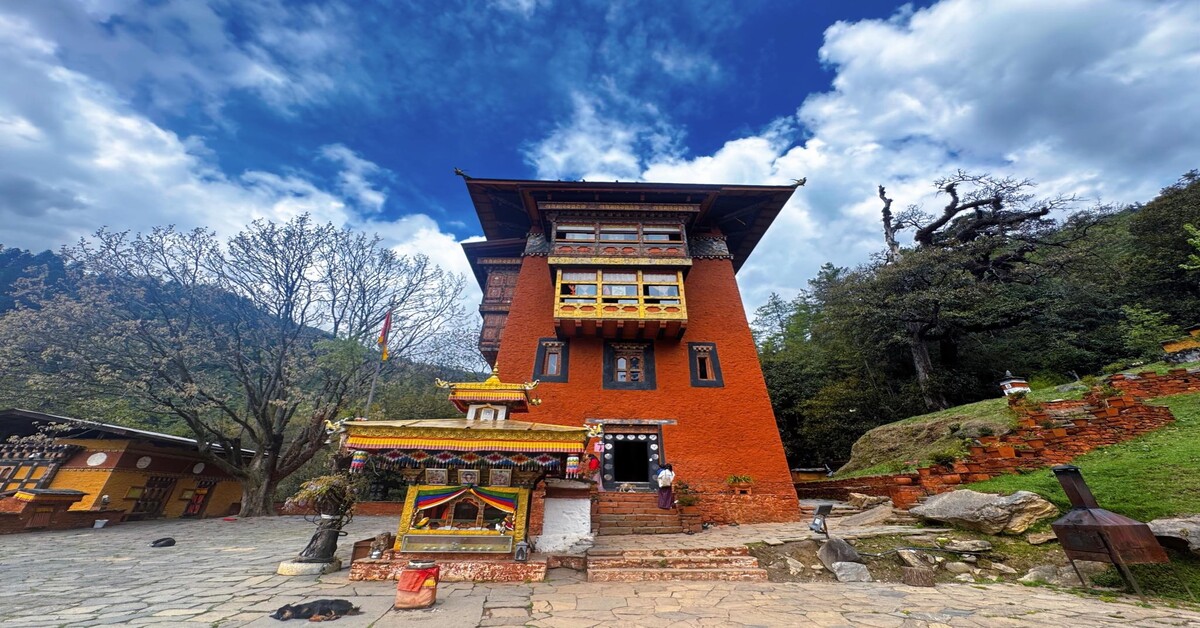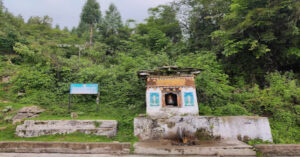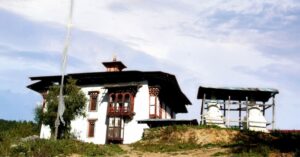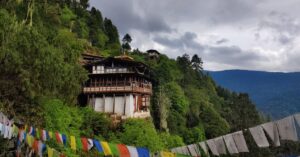Dechenphu Lhakhang, or Dechenphu Gyenyen Nyekhang, is the principal abode of Geynyen Jagpa Melen, the powerful guardian deity of Bhutan. It was founded by Dampa, the first son of Phajo Drugom Zhigpo, in the 12th century.
Dechenphu Geynyen Neykhang, located on the western slope of the north Thimphu valley, is one of the most visited monasteries in Bhutan to seek the deity’s protection before embarking on a new venture.
International tourists are not permitted to enter the Goenkhang of Dechenphu Lhakhang, but can visit the exterior and participate in festivals held in the courtyard.
You can also explore the nearby Pangri Zampa Monastery or hike to Geynyen Latsho, the life lake of Geynyen Jagpa Melen, which takes 7 hours from Dechenphug Lhakhang.
How To Reach Dechenphu Lhakhang
Dechenphu Gyenyen Lhakhang is just a 20-minute drive north of Thimphu town. You can use a taxi or a private car to reach the base of the hill close to the monastery. From the parking area, a short walk uphill leads to Dechenphug Neykhang.
Sacred Relics to See at Dechenphu Lhakhang
- The Statue of Geynyen;
- Shrines of protective deities;
- A speaking statue of Guru Padmasambhava;
- Statue of Buddha.
History of Dechenphu Lhakhang
According to Dechenphu Lhakhang’s history, Dechenphug, meaning the cave of consummate bliss, was an abode of Geynyen Jagpa Melen since time immemorial. However, it was only in the 12th century that Dechenphug got a monastery. Dechenphu Lhakhang was built by Dampa, son of Phajo Drugom Zhigpo, and became the first chief abbot.
Dampa invited his son Jop Kuenzang Dorji from Tango Choying Dzong to Dechenphu and became the second chief abbot of Dechenphu Monastery. Kuenzang Dorji established more drubdeys.
Later, Damtrul Loden Gyalpo, son of Jop Kuenzang Dorji, became the third chief abbot of Dechenphu. Loden Gyalpo, while in Druk Ralung, invited Jamyang Kuenga Sengye, the chief abbot of Druk Ralung, to Dechenphu in 1345.
On his arrival at Dechenphug, Kuenga Sengay was welcomed by Genyen Jagpa Melan in human form. Soon after this, Genyen dissolved into a rock, and this gave rise to the name of Thimphu, which means “Disappeared into the Stone.” During that occasion, Jamyang Kuenga Sengye administered Kago Damzha on Geynyen, converting him into the principal protector of Drukpa Kagyu.
Jamyang Kuenga Sengye and Damtrul Loden Gyalpo then constructed the Neykhang, also known as the Goenkhang of Geynyen, and installed the statue of Geynyen in 1346.
Drung Drung Gyalzom, one of the two sons of Damtrul Loden Gyalpo, became the fourth abbot of Dechenphu monastery, and thereafter his descendants continued to hold the position of abbot at Dechenphu. The other son, Drungdrung Gyalchog, who went to Druk Ralung to study, invited Gyalwangje Kuenga Peljor to Dechenphug. While at Dechenphu Monastery, Je Kuenga Peljor administered Kago Damzha in Geynyen. Thereafter, Drungdrung Gyalchog traveled to Paro and built Hungrel Dzong.
Geynyen Jagpa Melen
Who is Geynyen Jagpa Melen? Gyenyen Jakpa Melen, meaning “Fire Fetching Brigand and Supreme Warlord,” is an emanation of Yidam Tandin. However, his conduct was not very virtuous as he was born to Noejin Yobshue and Sinmo Dongmar. To transform him, the first Kago Damzha was delivered by Yidam Tandin and then by Guru Rinpoche at Yangleyshey in Nepal. In the 8th century, Guru Rinpoche came to Bhutan and bestowed Kago Damzhag again. Later, many Drukpa leaders administered Kago on him. Therefore, Gyenyen worked for many spiritual leaders who visited Bhutan in person. He also served Zhabdrung Ngawang Namgyal in person in the 17th century.
Importance of Dechenphu Geynyen Neykhang
Dechenphu Gyenyen Nyekhang is the main abode of Geynyen Jagpa Melen and the only one with an old and venerated structure, although there are seven Neykhangs of Geynyen. Hence, Ap Gyenyen is always envisioned as arising from Dechenphu in Bhutan, regardless of where invocations and rituals of Gyenyen are conducted.
Description of Dechenphu Lhakhang
When you enter the main gate and walk past a mani dungkhor and holy water, there’s a small shrine that houses the actual Thimphu stone, which serves as Geynyen’s abode in front of the main Goenkhang. It is believed to be sinking slowly.
The main structure of the Dechenphu Lhakhang complex is a Geynyen Neykhang, a fortified tower. Dechenphu Neykhang is painted red, with the gray-colored khemar band near the top, and has thick and sturdy walls. It’s roughly 19.4 meters in dimensions to the top of the ridgeline and about 10 meters on each side at ground level, with only a single entrance at its base to prevent the chance of attackers gaining easy entry.
The Goenkhang is divided into four floors. The ground floor, with the dimly lit entrance door, has a prayer wheel. The second floor, initially used as a meeting hall, is now a storeroom for offerings. The third floor is a large, well-lit worship hall dedicated to protective deities, including Mahakala (Yeshe Gonpo), the guardian deity of the Drukpa Kagyu. The walls are covered with many traditional weapons seized from the Tibetan invaders. The fourth floor is the Goenkhang, decorated with mural paintings on the walls. It houses a shrine of the Buddha.
Geynyen Neykhang was built below the residence of the chief abbot of Dechenphug. Later, Loden Gyalpo also constructed retreat centers below Geynyen Goenkhang. However, only the traces of the foundation of all the structures built above and below the present Geynyen Neykhang can be seen.
Above the Neykhang is the Lhakhang. This Lhakhang houses a speaking statue of Guru Padmasambhava.
Restoration and Rehabilitation of Geynyen Neykhang
The Fourth Druk Gyalpo Jigme Singye Wangchuck initiated the most significant restoration and rehabilitation works on Geynyen Neykhang on 18 January 1996 and concluded in 1998. During the restoration project, the wooden columns, girders, beams, and ceilings on the ground floor of the Geynyen Neykhang were restored. Restoration works also included the addition of wide window galleries, goma-rabseys to the second and third floors, and the mud plastering of the exterior walls of the Neykhang.
In addition, a large two-storey residence for the monks of Dechenphu was also constructed in front of the Geynyen Neykhang, and changed the approach path to the Neykhang as we see it today.
Festival of Dechenphu Lhakhang
Dechenphu Lhakhang Tshechu is a one-day festival dedicated to Gayngyen Jagpa Melen, initiated by His Majesty the King Jigme Singye Wangchuck in 2003. It is held annually on the 10th day of the 9th month of the Bhutanese calendar. The highlight of the Tshechu is Genyen Kuncham, apart from the other sacred mask dances of Zhana Nga Cham, Shazam Cham, and Nga Cham.
Best Time to Visit Dechenphu Lhakhang
There is no best time to visit Dechenphu Lhakhang; however, the annual Dechenphu Tshechu festival is a popular time to experience the vibrant traditional and mask dances. You are advised to visit the Lhakhang early, as it gets crowded by afternoon. You can visit the major pilgrimage sites of Thimphu with the Bhutan Pilgrimage Package.
Conclusion
Dechenphu Lhakhang, situated at the northern end of the Thimphu Valley, is a revered 12th-century monastery dedicated to the powerful protective deity, Geynyen Jagpa Melen. Built by Dampa, it features a fortified tower, a Goenkhang, and is a popular pilgrimage site for blessings and protection for the Bhutanese people.
Other Sacred Sites to Explore in Thimphu
Tashichho Dzong: Built in 1216 and rebuilt in 1962, it is a fortress-monastery that houses the king’s throne room, government offices, and the central monastic body. Known as the “Fortress of the Glorious Religion,” it blends religious and administrative functions with stunning Bhutanese architecture.
Pangri Zampa Monastery: It is one of Bhutan’s oldest monasteries, founded in the 16th century by Ngawang Chogyal, located 8 kilometers north of Thimphu on the west bank of the Thimphu River. The monastery now functions as Bhutan’s Royal College of Astrology, where monks study traditional astrology, and the college is responsible for determining dates for important national events.
Cheri Monastery: Also known as Chagri Dorjeden Monastery, it is the first monastery established in Bhutan by Zhabdrung Ngawang Namgyel in 1620. It is located in the Upper Thimphu Valley, about 15 kilometers north of Thimphu city, perched on a hill at an altitude of approximately 2,850 meters above sea level.
Tango Monastery: The Tango Choying Dzong was founded in the 13th century by Phajo Drugom Zhigpo and rebuilt in its current form in 1688 by the Fourth Temporal Ruler, Tenzin Rabgye. The monastery is perched on a forested hillside near Cheri Mountain, famed for its spiritual legends, particularly the prophecy involving the deity Hayagriva.
Tshelung Ney: Renowned as the “Second Draphu Maratika,” it is a sacred place of prophetic longevity where Guru Rinpoche received life empowerment (Tse Ngedrup) from Tsepakme (Amitayus) during the 8th century while meditating here for four months.
Thuji Dra Monastery: Also known as the Cliff of Compassion, it is one of the four cliffs prophesied by Guru Rinpoche to Phajo Drugom Zhigpo. The Thujidra Temple is located at an altitude of nearly 4,000 meters, where Phajo saw in a vision Phagpa Thujechenpo while meditating here.
Enjoyed reading this blog?




